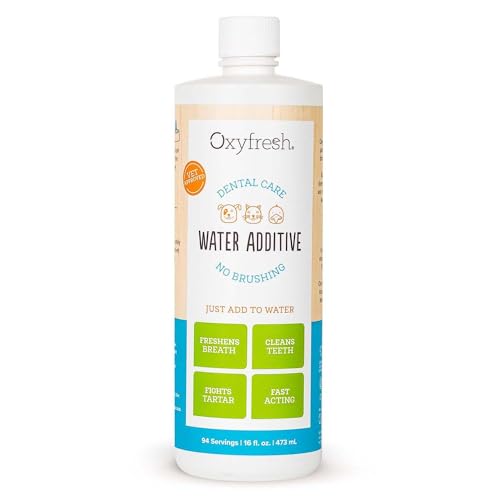


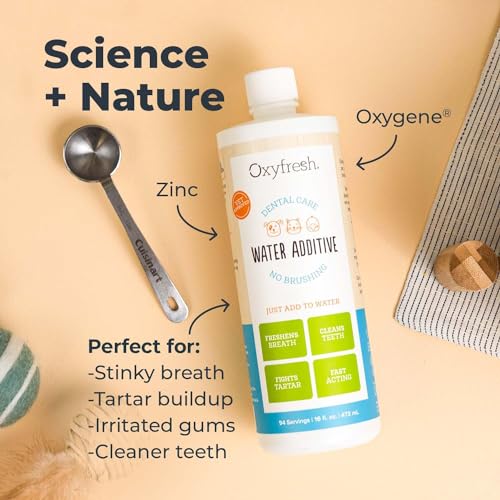
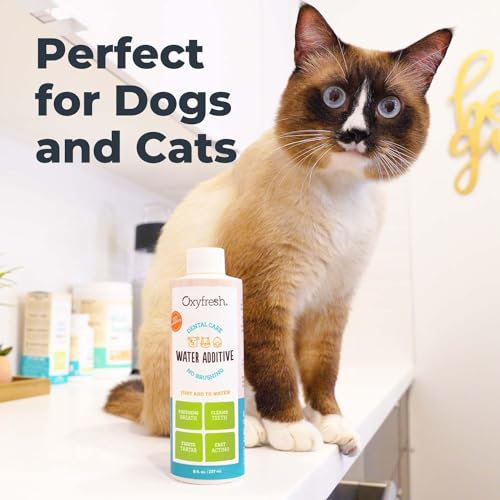
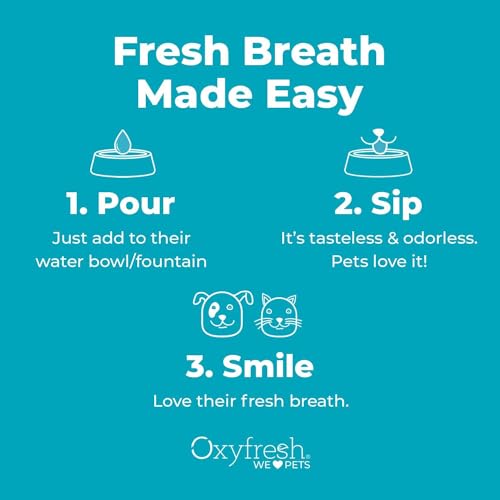
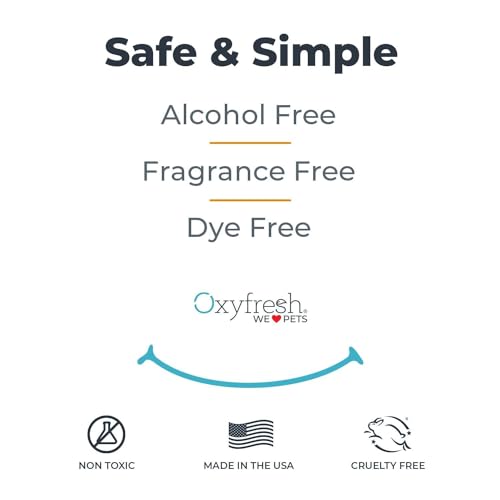
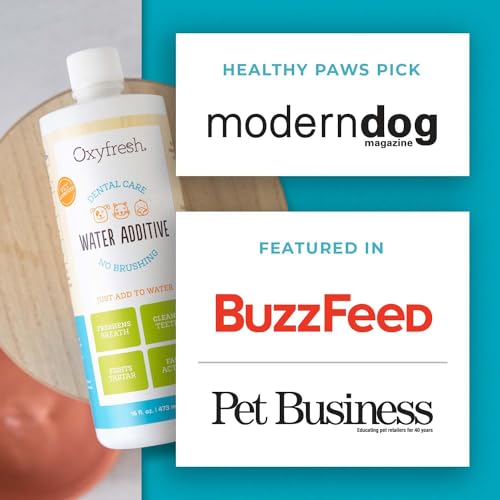
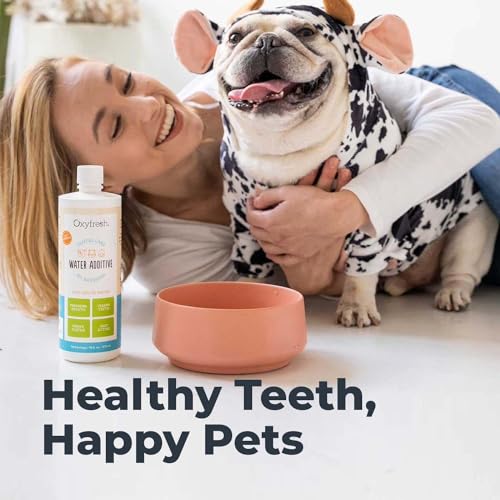
Oxyfresh Pet Dental Care Solution - Eliminates Bad Breath, Fights Plaque & Tartar - 16oz


Sodium Hydroxide
High RiskSodium hydroxide is a highly caustic and reactive inorganic compound commonly used as a pH adjuster in various products. It is effective in neutralizing acids and plays a role in the production of soaps and detergents.
Sustai Insights
Sodium hydroxide serves essential functions, particularly in adjusting pH levels, but poses significant health risks, including skin and eye irritation. It is subject to high usage restrictions due to its corrosive nature. Environmental concerns include its potential to pollute water sources and contribute to ecosystem damage. Regulatory bodies have imposed strict guidelines on its use, indicating a high-risk profile for products containing this ingredient. Safe handling practices are crucial, and alternatives include milder pH adjusters, emphasizing the need for caution in its application.
Zinc Acetate
High RiskZinc acetate is a zinc salt of acetic acid. It is commonly used in various products for its role in providing zinc, an essential trace element, which is important for numerous biological functions.
Sustai Insights
Zinc acetate effectively serves as a zinc supplement and can enhance skin health and wound healing. However, regulatory warnings indicate high usage restrictions, and while it poses low risks for cancer, allergies, and reproductive toxicity, concerns exist regarding its persistence and bioaccumulation in the environment. Given these factors, the overall risk level is assessed as high, necessitating cautious usage and consideration of safer alternatives.
Ci 75810
High RiskChlorophyllin-copper complex is obtained from chlorophyll, the green pigment in plants, and is commonly used in cosmetic and personal care products for its coloring and potential skin benefits. It serves as a stabilizer and can impart a green hue, enhancing product aesthetics.
Sustai Insights
Chlorophyllin-copper complex offers functional benefits as a colorant and stabilizer in formulations. However, its regulatory status is high-risk due to usage restrictions, and while health concerns like carcinogenicity, allergies, and reproductive toxicity are low, its potential environmental impacts, including persistence and bioaccumulation, are significant. Regulatory bodies have issued restrictions on its use, leading to an overall high-risk assessment. Safe usage practices should be observed, and alternatives like natural colorants may be considered.
Sodium Benzoate
Medium RiskSodium benzoate is a preservative commonly used in food and cosmetic products to prevent microbial growth and extend shelf life. It is derived from benzoic acid and is effective at low concentrations, often used in acidic environments like beverages and condiments.
Sustai Insights
Sodium benzoate serves effectively as a preservative, contributing to product stability and safety. It is generally recognized as safe with low concerns for carcinogenicity, allergies, and reproductive toxicity, though it faces moderate use restrictions in some regions. Environmental risks include its potential as a pollutant, but it does not bioaccumulate significantly. Regulatory bodies have issued advisories regarding its concentration in products. Overall, the risk level is assessed as medium, with safe usage practices recommended. Alternatives such as potassium sorbate may provide similar benefits with potentially lower restrictions.
Sodium Citrate
Low RiskSodium citrate is used in cosmetic formulations primarily as a buffering agent, helping to stabilize pH levels. It is derived from citric acid and is commonly found in various personal care products to enhance their efficacy and stability.
Sustai Insights
Sodium citrate offers functional benefits such as effective pH regulation and acts as a mild preservative. It is generally recognized as safe with low risks for cancer, allergies, and reproductive toxicity. Environmental concerns are minimal, with no significant pollutant potential or bioaccumulation. Regulatory bodies like the FDA and COSMOS have no major restrictions on its use. Overall, sodium citrate presents a low risk, making it a viable ingredient in cosmetic formulations. Safe usage practices should be followed, and alternatives are not typically necessary.
Water
Low RiskWater is a clear, colorless liquid essential for various biological processes. It serves as a solvent in formulations, facilitating the dissolution of other ingredients and enhancing product texture and application. Additionally, water plays a crucial role in hydration and is a key component in many cosmetic and personal care products.
Sustai Insights
Water is an effective solvent and hydrator, contributing to the texture and efficacy of formulations. It is biodegradable and generally regarded as safe, with low concerns regarding carcinogenicity, allergies, and reproductive toxicity. However, excessive water usage can lead to environmental concerns, particularly regarding resource depletion. Regulatory bodies do not impose restrictions on water use in cosmetics. Overall, the risks associated with water are low, making it a safe and essential ingredient.
Sodium Citrate
Low RiskSodium citrate is used in cosmetic formulations primarily as a buffering agent, helping to stabilize pH levels. It is derived from citric acid and is commonly found in various personal care products to enhance their efficacy and stability.
Sustai Insights
Sodium citrate offers functional benefits such as effective pH regulation and acts as a mild preservative. It is generally recognized as safe with low risks for cancer, allergies, and reproductive toxicity. Environmental concerns are minimal, with no significant pollutant potential or bioaccumulation. Regulatory bodies like the FDA and COSMOS have no major restrictions on its use. Overall, sodium citrate presents a low risk, making it a viable ingredient in cosmetic formulations. Safe usage practices should be followed, and alternatives are not typically necessary.
Sodium Hydroxide
High RiskSodium hydroxide is a highly caustic and reactive inorganic compound commonly used as a pH adjuster in various products. It is effective in neutralizing acids and plays a role in the production of soaps and detergents.
Sustai Insights
Sodium hydroxide serves essential functions, particularly in adjusting pH levels, but poses significant health risks, including skin and eye irritation. It is subject to high usage restrictions due to its corrosive nature. Environmental concerns include its potential to pollute water sources and contribute to ecosystem damage. Regulatory bodies have imposed strict guidelines on its use, indicating a high-risk profile for products containing this ingredient. Safe handling practices are crucial, and alternatives include milder pH adjusters, emphasizing the need for caution in its application.
Zinc Acetate
High RiskZinc acetate is a zinc salt of acetic acid. It is commonly used in various products for its role in providing zinc, an essential trace element, which is important for numerous biological functions.
Sustai Insights
Zinc acetate effectively serves as a zinc supplement and can enhance skin health and wound healing. However, regulatory warnings indicate high usage restrictions, and while it poses low risks for cancer, allergies, and reproductive toxicity, concerns exist regarding its persistence and bioaccumulation in the environment. Given these factors, the overall risk level is assessed as high, necessitating cautious usage and consideration of safer alternatives.
Ci 75810
High RiskChlorophyllin-copper complex is obtained from chlorophyll, the green pigment in plants, and is commonly used in cosmetic and personal care products for its coloring and potential skin benefits. It serves as a stabilizer and can impart a green hue, enhancing product aesthetics.
Sustai Insights
Chlorophyllin-copper complex offers functional benefits as a colorant and stabilizer in formulations. However, its regulatory status is high-risk due to usage restrictions, and while health concerns like carcinogenicity, allergies, and reproductive toxicity are low, its potential environmental impacts, including persistence and bioaccumulation, are significant. Regulatory bodies have issued restrictions on its use, leading to an overall high-risk assessment. Safe usage practices should be observed, and alternatives like natural colorants may be considered.
Sodium Benzoate
Medium RiskSodium benzoate is a preservative commonly used in food and cosmetic products to prevent microbial growth and extend shelf life. It is derived from benzoic acid and is effective at low concentrations, often used in acidic environments like beverages and condiments.
Sustai Insights
Sodium benzoate serves effectively as a preservative, contributing to product stability and safety. It is generally recognized as safe with low concerns for carcinogenicity, allergies, and reproductive toxicity, though it faces moderate use restrictions in some regions. Environmental risks include its potential as a pollutant, but it does not bioaccumulate significantly. Regulatory bodies have issued advisories regarding its concentration in products. Overall, the risk level is assessed as medium, with safe usage practices recommended. Alternatives such as potassium sorbate may provide similar benefits with potentially lower restrictions.
Water
Low RiskWater is a clear, colorless liquid essential for various biological processes. It serves as a solvent in formulations, facilitating the dissolution of other ingredients and enhancing product texture and application. Additionally, water plays a crucial role in hydration and is a key component in many cosmetic and personal care products.
Sustai Insights
Water is an effective solvent and hydrator, contributing to the texture and efficacy of formulations. It is biodegradable and generally regarded as safe, with low concerns regarding carcinogenicity, allergies, and reproductive toxicity. However, excessive water usage can lead to environmental concerns, particularly regarding resource depletion. Regulatory bodies do not impose restrictions on water use in cosmetics. Overall, the risks associated with water are low, making it a safe and essential ingredient.
Discover the Oxyfresh Premium Pet Dental Care Solution, the effortless way to keep your furry friends' breath fresh and their teeth healthy. This veterinarian-recommended water additive eliminates bad breath, fights tartar and plaque, and is perfect for pets who are picky about their food and drink.
- Fresh Breath Made Easy: Quickly eliminate dog and cat bad breath with a simple addition to their water bowl, ensuring a pleasant interaction every time.
- Dental Health Support: Helps maintain clean teeth and gums by actively fighting plaque and tartar buildup, promoting overall oral hygiene.
- No More Toothpaste Battles: Skip the hassle of brushing and just add a capful to your pet's water for an effortless dental care routine.
- Pet-Friendly Formula: Odorless and tasteless, this solution is free from harmful mint or tea tree oil, ensuring your pet enjoys clean water without any fuss.
- Quality You Can Trust: Made in the U.S.A. with safe, high-quality ingredients, this product is 100% non-toxic and ideal for long-term use.
Keep your pets healthy and happy with Oxyfresh, the smart choice for conscientious pet owners.
Subscribe & Save with Sustai
- Best Price Guarantee: Always enjoy the lowest prices on sustainable home essentials.
- No Surprises: We’ll notify you before shipping. No hidden fees, ever.
- You’re in Charge: Change, pause, or cancel your subscription anytime with ease.
- Eco-Friendly Deliveries: Our grouped shipments mean less packaging and lower emissions.
Join us on a sustainable journey. Special offers for a limited time! Prices and promotions may change.
Recommended Products
Discover the Oxyfresh Premium Pet Dental Care Solution, the effortless way to keep your furry friends' breath fresh and their teeth healthy. This veterinarian-recommended water additive eliminates bad breath, fights tartar and plaque, and is perfect for pets who are picky about their food and drink.
- Fresh Breath Made Easy: Quickly eliminate dog and cat bad breath with a simple addition to their water bowl, ensuring a pleasant interaction every time.
- Dental Health Support: Helps maintain clean teeth and gums by actively fighting plaque and tartar buildup, promoting overall oral hygiene.
- No More Toothpaste Battles: Skip the hassle of brushing and just add a capful to your pet's water for an effortless dental care routine.
- Pet-Friendly Formula: Odorless and tasteless, this solution is free from harmful mint or tea tree oil, ensuring your pet enjoys clean water without any fuss.
- Quality You Can Trust: Made in the U.S.A. with safe, high-quality ingredients, this product is 100% non-toxic and ideal for long-term use.
Keep your pets healthy and happy with Oxyfresh, the smart choice for conscientious pet owners.

You can have at most 2 Sustainable Steals products in your cart
Customer Reviews
Customers’ View
Customers report positive experiences with the Pet Dental Care Solution, noting its effectiveness in eliminating bad breath and reducing plaque and tartar buildup. Many users appreciate the product's odorless and tasteless formula, which makes it easy to incorporate into their pets' daily routines. Specific benefits highlighted include noticeable improvements in breath quality and dental cleanliness, with several customers mentioning their pets' teeth appear whiter and healthier. However, some users have experienced gastrointestinal issues, such as diarrhea, indicating the importance of monitoring pets' reactions. Overall, this product is viewed favorably by consumers who prioritize their pets' oral health, and its vet-recommended status adds to its credibility.
AI-generated from the text of customer reviewsThis product is rated 4.3 of 5.0 stars.
It has received 91 reviews.




